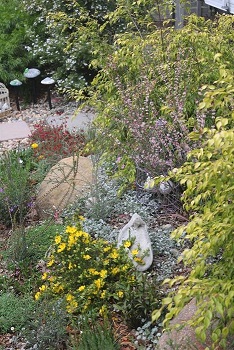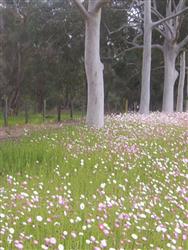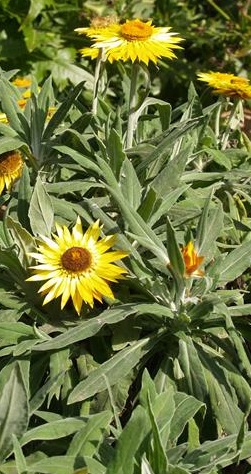 Learn more about Australian Native plants - soft wooded and hard wooded.
Learn more about Australian Native plants - soft wooded and hard wooded.
This course deals with both woody (hard wooded) and herbaceous (soft wooded), low growing Australian Native Plants, which bear showy wildflowers.
- Learn about Australia's beautiful wildflowers including cultivation and commercial applications.
- Develop your ability to identify, select, cultivate and explain commercial applications for appropriate varieties of low growing Australian native flowering plants in a variety of situations.
Comment from one of our Australian Natives II students:
"The plant recognition assignments were challenging and a great help for the future" D. Sydenham
CONTENT
There are 8 lessons as outlined below:-
1. Introduction
- scope and nature of wildflowers
- review of the system of plant identification
- general characteristics of the group
- information contacts (ie: nurseries, seed, clubs, etc.)
2. Growing Conditions
- Planting
- staking
- mulching
- watering
- pest & disease
- feeding
- pruning
- propagation
- protection from wind, salt air, environmental zones, etc.
3. The Heaths and similar plants
- Myrtaceae family and other small natives
- Thryptomene
- Bauera
- Astartea
- Grevilleas
- Telopea
- Leptospermum, etc.
4. The Daisy Family
- Helichrysum, Bracteantha, Helipterum
- Celmisia
- Brachyscome
- Olearia, etc.
5. The Legumes
- Fabaceae
- Mimosaceae
- Caesalpinaceae
- Kennedya
- Pultenaea
- Acacia, etc.
 6. Other common groups
6. Other common groups
- Boronia
- Crowea
- Clematis
- Viola, etc.
7. The Monocots
- Grasses
- native irises
- Anigozanthus
- Xanthorrhea, etc.
8. Commercial Applications
Aims
- Distinguish between different types of native wildflowers.
- Determine reliable information about the identification and culture of Australian wildflowers.
- Specify general cultural practices, including propagation, for different families of Australian native wildflowers.
- Explain the characteristics, including identification and culture, of heath like native wildflowers; with reference to both proteaceous and myrtaceous plants.
- Explain the characteristics, including their identification, culture and use, of wildflowers in the Asteraceae (ie. Daisy) family.
- Explain the characteristics, including identification, culture and use, of different legume wildflower genera.
- Explain the characteristics, including identification, culture and use, of different Australian native monocotyledons (ie. narrow-leaved plants).
- Prepare a planting design featuring Australian wildflowers.
- Develop a cut flower production plan, for a selected Australian wildflower.
Examples of Tasks in the Course
 Distinguish, using illustrations and minimum but adequate comments, between twenty different plant families within which Australian native wildflowers are commonly found, including the following: Asteraceae, Caesalpiniaceae, Dilleniaceae, Epacridaceae, Ericaceae, Fabaceae, Poaceae, Haemodoraceae, Iridaceae, Lamiaceae, Liliaceae, Mimosaceae, Myrtaceae, Orchidaceae, Proteaceae, Rutaceae and Thymelaceae.
Distinguish, using illustrations and minimum but adequate comments, between twenty different plant families within which Australian native wildflowers are commonly found, including the following: Asteraceae, Caesalpiniaceae, Dilleniaceae, Epacridaceae, Ericaceae, Fabaceae, Poaceae, Haemodoraceae, Iridaceae, Lamiaceae, Liliaceae, Mimosaceae, Myrtaceae, Orchidaceae, Proteaceae, Rutaceae and Thymelaceae.- Prepare a collection of fifty pressed wildflower specimens (or illustrations), not collected elsewhere with information included on culture and use.
- Compile a resource file of sources of information on native wildflowers.
- Develop criteria for distinguishing the accuracy of information, relating to native wildflowers.
- Determine four reliable sources, of accurately named Australian plant material, including both seed and plants.
- Develop a procedure for researching cultural information on an unfamiliar species of Australian wildflower, listing specific information sources in order of importance.
- Explain two different ways to plant each of three, different specified wildflower plants
- Compare the use of four different types of mulch, around specified wildflowers.
- Explain appropriate techniques for watering Australian wildflowers, in a specified garden.
- Compare the pruning of two specified wildflowers, from two different taxonomic families.
- Explain why three different Australian wildflower plants have different preferences in soils.
- Compare the use of five different types of fertiliser on Australian wildflower plants.
- Propagate wildflower plants using four different techniques (eg. Seed, Cuttings).
- Identify pests and diseases afflicting at least three different Australian wildflowers.
- Discuss the culture of fifteen different Australian wildflower plants.
- Distinguish, using illustrations and minimum but adequate comments, between genera which include heath-like native plants, including:
- Epacris
- Micromyrtus
- Thryptomene
- Verticordia
- Grevillea
- Isopogon
- Melaleuca
- Pimelia.
- Prepare a poster size chart which compares the characteristics, including:
- Appearance
- Propagation
- Lifespan
- Soil requirements
- Environmental requirements
- Pests & diseases
- Special cultural techniques of various different genera of heath-like wildflowers.
- Describe the unique characteristics of different genera of wildflowers
- Dissect, draw and label the parts of a daisy flower, including:
- Ligule
- Stigma
- Style
- Anther
- Corolla tube
- Pappus
- Ovary
- Receptacle
- Disc floret
- Ray floret.
- Distinguish, using illustrations, between three different native daisy genera.
- Design a garden bed using only Australian native daisy flowers which will grow in your locality, and will flower for an optimum period of months over the year.
- Produce dried flowers from an appropriate native plant variety in the Asteraceae family.
- Distinguish between Fabaceae, Caesalpiniaceae & Mimosaceae families characteristics.
- List fifteen of the more commonly grown native legume genera.
- Describe various uses for specific legume native genera, including:
- Soil improvement
- Flower colour
- Weed suppression
- Erosion control
- Decorative foliage
- Screening as a climber.
- Write an essay comparing the characteristics of four different Australian Native legume genera.
- List twenty species of low growing native monocotyledons suited to culture in your locality
- Describe various uses for monocotyledon native species listed, including:
- Soil improvement
- Flower colour
- Weed suppression
- Erosion control
- Decorative foliage
- Screening.
- Design a garden bed of 20 square metres, using only Australian native monocotyledons which will grow in your locality; to be colourful for an optimum period of months during the year.
- Determine applications for five different species of wildflowers, in amenity horticulture.
- Grow a combination of three different wildflower varieties in an area of four square metres, to achieve an aesthetically attractive display of colour.
- Prepare a scale drawing for a design of a 40 square metre garden bed which features wildflowers, and creates a high impact colourful display for a period of at least two months.
- Develop criteria for selection of a wildflower species to grow as a commercial crop.
- Determine ten different species of wildflowers which have potential as a commercial cut flower crop, in your locality.
- Design & conduct simple trial for testing the performance of three specimens of a selected wildflower species, and summarise the trial procedure, detailing: *What to grow *Schedule of cultural tasks *List of equipment and materials required
- Evaluate the commercial potential of the different cut flowers.
- Devise a crop production schedule for a specified cut flower crop, detailing all essential work tasks.
WHAT NEXT?
Register to Study - Go to “It’s Easy to Enrol” box at the top of the page and you can enrol now.
or
Get Advice – Email us at info@acsedu.co.uk OR
Use our FREE COUNSELLING SERVICE to contact a tutor
CLICK TO CONTACT US